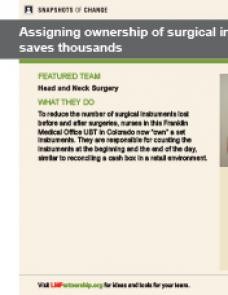TOOLS
TOOLS
TOOLS
TOOLS
HANK Winter 2013
Keeping Better Track of Your Surgical Instruments
Deck
Team creates inventory system and saves $25,000
Surgeons need delicate and expensive tools to work.
And with 900 instruments being used and processed for reuse daily in a Head and Neck Surgery department, it’s not hard to lose an instrument.
But replacement at several hundred dollars a pop is expensive.
So, when the Head and Neck team at the Franklin Medical Office in Colorado heard that a reduced budget would not cover lost instruments, team members knew they had to act.
“When we came up to the crisis, we brainstormed through it,” says labor co-lead Angela Garcia, RN, and UFCW Local 7 member.
The team tested several ideas, including color-coding instruments with tape—a change that wasn’t adopted because of infection control issues and it didn’t work.
Then the team tried divvying up the instruments among the 20 patient rooms and two procedure rooms. That didn’t work, either, because each physician has his or her own preference for certain instruments, and the staff didn’t know where the instruments would be needed.
“Nobody was taking responsibility of the instruments,” Garcia says. “We needed to hold people responsible for what they were using.”
The UBT purchased plastic bead boxes from a local craft store and labeled each box by nurse. The nurse was in charge of the box, just as a store clerk is responsible for a cash box. Nurses checked the inventory at the beginning and end of each shift to make sure their boxes balance, and if something was missing, they were responsible for finding it.
The team also took time to educate the entire staff about the process, and explain both how valuable and how fragile the instruments are. This helped everyone understand the reason for the change, and inspired everyone to be more responsible.
“I think the idea of coming up with the system was ingenious,” says Liz Vandyck, a clinical audiologist and member of UFCW Local 7. The team also did monthly audits to measure success.
The team had spent more than $26,000 replacing 300 lost instruments. A year after the successful test of change, only five instruments needed replacing—two were lost and three were broken.
“This was a really interesting way to solve the problem,” says Lorana Brass, MD, one of the department's physicians.







